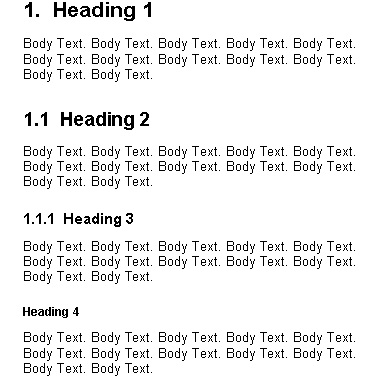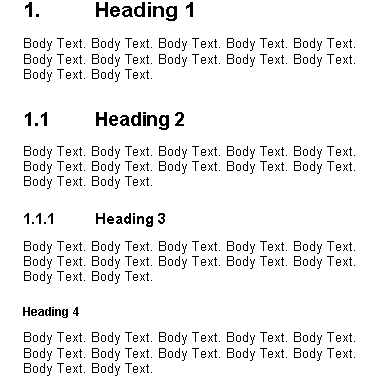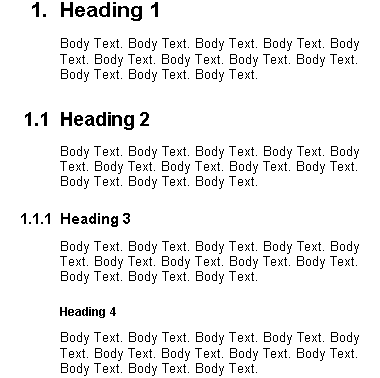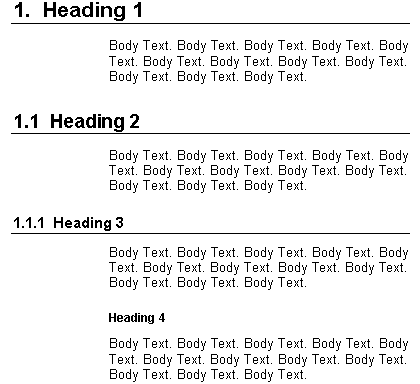HCIRN
Human-Computer Interaction Resource Network
Home > Tutorials > Designing Documents > Headings
Headings
Headings organize a document into meaningful sections.
Headings should be limited to four levels.
In technical documents, headings are frequently numbered. Numbering should be limited to the first three heading levels. Commonly numbers on the first level end with a period, whereas numbers on subsequent levels do not.

Figure 1: Numbered headings
Headings on the first level frequently start a new page.
Headings are often set in bold or italic or both in order to make them stand out from the body. We prefer bold to italic.
Different levels of headings should be distinguished by different type sizes. The type sizes should be at least 2 points apart. Headings on the lowest level are usually set in about the same type size as the body. Since text set in bold appears larger than text set in a regular typeface, we often set the lowest level of heading in a type size that is actually a point smaller than the body text. For example, if the body is set in a 10-point font, heading 4 is set in 9 point, heading 3 in 11 point, heading 2 in 14 point and heading 1 in 16 point.
The space before and after headings should increase with heading level. The space should increase by at least 2 points for each level of heading. The space before headings should be about twice the space after headings. The space after the lowest level heading should be at least the same as the space between block paragraphs, i.e., 60-80% of the line height of the body text.
For example, if the space between block paragraphs is 8 points, then heading 4 has a space after of 8 points and a space before of 16 points, heading 3 has a space after of 10 points and a space before of 20 points, etc. However, we prefer to use less spacing. In our style template, heading 4 and heading 3 both have space after of 8 points and space before of 16 points, heading 2 has space after of 10 and space before of 20 points, and heading 1 has also space after of 2 points and no space before since it always starts a new page.

Figure 2: Heading type sizes and spacings
Headings are usually either left-aligned or center-aligned. For technical documents we prefer left-aligned.
If numbered headings span more than one line, then subsequent lines should be flush-left with the text of the first line.

Figure 3: Multi-line heading
There are many different variations of headings. For numbered headings, a cleaner appearance is achieved if all levels have the same indentation.

Figure 4: Indented headings
Numbers can also be right-aligned rather than flush-left with the text body.

Figure 5: Right-aligned heading numbers
In a hanging-indent heading the entire heading is pulled out to the left. In this case a rule after the heading is required in order to tie the heading and the text together.

Figure 6: Hanging-indent heading
The lowest level of heading may be set as a run-in head.
![]()
Figure 7: Run-in head
Or it may be set as a side head. The side head should be set flush-right and the space between the side head and the text should be about 0.1 in. (~3 mm).
![]()
Figure 8: Side head